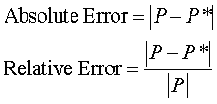|
[ Index ] |
|

|
[ Index ] |
|


Chop-off vs. Round-off
Example:
Pi=3.141592654...
use 3 digits for fraction:
Chop-off: 3.141
Round-off: 3.142
Round-off is more accurate since it produces the least relative error
Propagation Errors
Assume p and q are approximated by p* and q* such that:
p*=p+ep, q*=q+eq
Sum: p* + q* = p + q + (ep + eq)
| |||||
Product: p* q* = (p+ep)(q+eq)=pq+p(eq)+q(ep)+(ep)q+(ep)(eq)
|
Algorithm stability
An algorithm is:
| Stable - If small initial errors stay small | |
| Unstable - If small initial errors get large after several iterations |
Webpage by Emil Stefanov